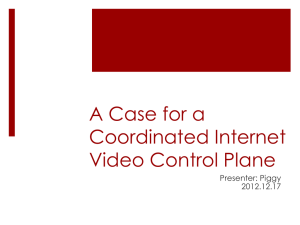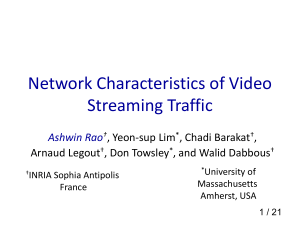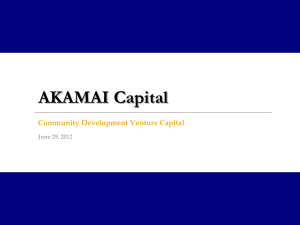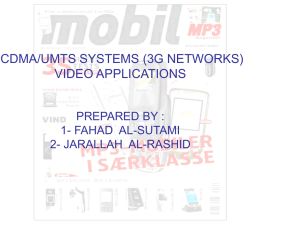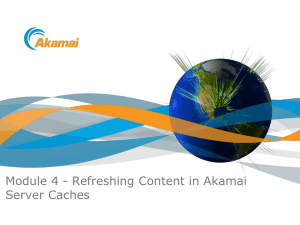Content Delivery Network
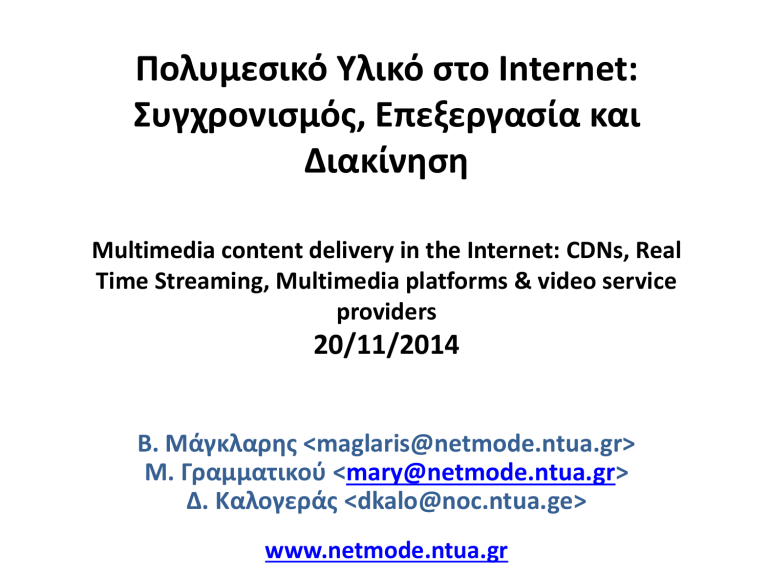
Πολυμεσικό Υλικό στο Internet:
Συγχρονισμός, Επεξεργασία και
Διακίνηση
Multimedia content delivery in the Internet: CDNs, Real
Time Streaming, Multimedia platforms & video service providers
20/11/2014
Β. Μάγκλαρης <maglaris@netmode.ntua.gr>
Μ. Γραμματικού < mary@netmode.ntua.gr
>
Δ. Καλογεράς <dkalo@noc.ntua.ge> www.netmode.ntua.gr
Outline
• Content Delivery Networks (CDNs)
• Video on Demand servers/clouds
• Real Time Streaming
Content Delivery Networks (CDNs)
http://en.wikipedia.org/wiki/Content_delivery_network
• The first generation CDNs were not encountered before the late 90′s
• CDN is a large distributed system of servers deployed in multiple data centers across the Internet
• It serves content to end-users with high availability and high performance
• It serves a large fraction of the Internet content :
– including web objects (text, graphics and scripts), downloadable objects
(media files, software, documents), applications (e-commerce, portals), live steaming media, on-demand streaming media, and social networks
Single server distribution and CDN distribution
Notable Content Delivery Service Providers http://en.wikipedia.org/wiki/Content_delivery_network
Free CDNs [ edit ]
• BootstrapCDN
• CloudFlare
• Coral Content Distribution Network
• Incapsula (free version with Incapsula advertisement)
Traditional commercial CDNs [ edit ]
• Akamai Technologies
• Amazon CloudFront
• Aryaka
• Windows Azure CDN
• CacheFly
• CDNetworks
• ChinaCache
• Cotendo (acquired by Akamai)
• Distil Networks
• EdgeCast Networks
• Highwinds Network Group
• HP Cloud Services
• Incapsula
• Internap
• LeaseWeb
• Level 3 Communications
• Limelight Networks
• MaxCDN
• MegaFon
• MetaCDN
• Mirror Image Internet
• NACEVI
• OnApp
• OVH
• Rackspace Cloud Files
• Speedera Networks (acquired by Akamai)
• StreamZilla CDN Europe
Telco CDNs [ edit ]
• AT&T Inc.
• Bharti Airtel
• Bell Canada
• BT Group
• Deutsche Telekom
• Hibernia Networks
• KT (formerly Korea Telecom)
• KPN
• Level 3 Communications
• MegaFon
• NTT
• Pacnet
• PCCW
• Qualitynet
• SingTel
• SK Broadband
• Tata Communications
• TeliaSonera
• Telecom Argentina
• Telecom Italia
• Telecom New Zealand
• Telefonica
• Telenor
• Telstra
• Telus
• Turk Telekom
• Verizon
Commercial CDNs using P2P for delivery [ edit ]
• BitTorrent, Inc.
• Internap
• Pando Networks
• Rawflow
CDN 2014 – 2017: Operations and Analytics http://www.reportsnreports.com/reports/287274-cdn-2014-2017-operations-andanalytics.html
• CDN (Content Delivery Network) revenue is projected at $3.36
billion in 2014, up 19%,directed by user appetite for self-selected content
• Total 2013 commercial value of media and entertainment video
(views and advertising), movie/TV files, music listening and downloads (including self-hosting entities such as Google and
Amazon) stood at $3.35 billion, of which $1.05 billion (31.3%) was delivered through CDN contracts
• Video viewing and advertising (combining self-hosted networks),
TV/ movies and music accounted for 2.4+ billion gigabytes of data transfer, worth $1.6 billion in commercial market value (bandwidth and co-lo fees only), when priced at prevailing rates and against a volume (gigabytes delivered) model.
• CDNs include Akamai Technologies, Limelight Networks, Cd Networks, China Cache,
Mirror Image, Level 3, High winds, Cloud flare, Tata Communications and MaxCDN, among others
Published By: AccuStream Research
Content Delivery Networks
http://www.globaldots.com/the-history-of-content-delivery-networks-cdn
• In the past, the development of CDNs sought to deal with extreme bandwidth pressures, first as video streaming was growing in demand as well as the number of content providers
• Now, CDNs are a continual trend, with the emergence of utility - cloud computing, charging end-users on demand and involving all layers of cloud computing:
– SaaS (Software as a Service), e.g. Google Docs, Amazon
CloudFront
– PaaS (Platform as a Service) e.g. Google App Engine
– IaaS (Infrastructure as a Service), e.g. GRNET Okeanos,
Amazon EC2
Layers of Cloud Computing
http://www.globaldots.com/the-history-of-content-delivery-networks-cdn
Content Νetworking Τechniques
• The Internet was designed according to the end-to-end
neutrality principle. Core network : simple and moves the intelligence to the network end-points (hosts, clients)
• CDNs distribute a variety of applications employing techniques to optimize content delivery. The resulting tightly integrated overlay uses web caching, server-load balancing, request routing, and content services
– Web caches store popular content on servers that have the greatest demand for the content requested
– Server-load balancing uses one or more techniques including servicebased (global load balancing) or hardware-based
• A variety of algorithms are used to route appropriately the request. These include Global Server Load
Balancing, DNS-based request routing, Dynamic metafile generation, HTML rewriting and anycasting
Content Delivery Networks (CDNs)
Content Delivery Networks State of the Art, Insights, and Imperatives_2008,
Mukaddim Pathan, Rajkumar Buyya and Athena Vakali
• Most CDNs are operated as an Application Service
Provider (ASP) on the Internet (also known as ondemand software or SaaS) targeting Content
Providers, web administrators etc., wishing to optimize delivery to end-users
• CDN Service and Functionalities:
– Storage and Management of content
– Distribution of content among edge servers
– Cache management
– Delivery of encoded media
– Backup and disaster recovery solutions
– Monitoring and Performance
P2P and Private CDNs
• Peer-to-peer CDNs
– In P2P content-delivery networks, clients provide resources as well as use them, so the content serving capacity of P2P networks can actually increase as more users begin to access the content
• Private CDNs
– The owners create their own CDN
– A private CDN consists of Points of Present (PoPs) that are only serving content for their owner
Top International CDNs make deals directly with ISPs and/or Internet Exchanges http://blog.streamingmedia.com/2014/07/apples-cdn-now-live.html
https://peering.google.com/about/
• Apple’s CDN Now Live: Has Paid Deals With
ISPs, Massive Capacity In Place
• Google Peering and Content Delivery
– Data centers
– Backbone
– Edge Points of Presence (POPs)
– Google's edge caching infrastructure
• Netflix Announces New Content Delivery
Network, Offering Free Caches To ISPs
A Pioneer Content Delivery Network (CDN): Akamai http://www.akamai.com/html/about/company_history.html
Erik Nygren, Ramesh K. Sitaraman, Jennifer Sun, The Akamai Network: A Platform for High-Performance Internet Applications
• Akamai's beginnings lie in a challenge posed by World Wide
Web inventor Tim Berners-Lee at MIT in early 1995
• The company launched commercial service in April 1999
• The platform is made up of a distributed network of servers and intelligent software, delivering over two trillion interactions daily
• The Akamai Intelligent Platform is constantly monitoring Web conditions to:
– Identify, absorb, and block security threats
– Provide instant device-level detection and optimization
– Make decisions based on comprehensive knowledge of network conditions
– Present unprecedented business and technical insights
Akamai
Erik Nygren, Ramesh K. Sitaraman, Jennifer Sun, “The Akamai Network: A
Platform for High-Performance Internet Applications”, ACM SIGOPS Operating
Systems Review, Vol. 44, No 3, July 2010
The figure above shows how Akamai maintained high connectivity for customers during the 2008 cable cuts that caused widespread Internet outages in the Middle East, Asia, and Africa.
Video-on-Demand
http://en.wikipedia.org/wiki/Video_on_demand http://en.wikipedia.org/wiki/IPTV
• Video-on-Demand (VoD) are systems which allow users to select and watch/listen to video or audio content when they choose to, rather than having to watch at a specific broadcast time. IPTV technology is often used to bring video on demand to televisions and personal computers
• IPTV or IP/TV was developed as a multimedia service for television/video/audio/text/graphics/data delivered over IP based networks managed to provide the required level of quality of service and experience, security, interactivity and reliability (initially developed by Precept Software in 1995, acquired by Cisco in
1998)
Video-on-Demand
http://en.wikipedia.org/wiki/Video_on_demand
• Pay-Per-View (PPV) is a type of pay television service by which a subscriber of a service provider (cable TV, Satellite and Broadband
Internet) can purchase events/shows/programs
• In 2006, HBO generated 3.7 million PPV buys with $177 million in gross sales
• In 2007, HBO sold 4.8 million PPV buys with
$255 million in sales
Video-on-Demand Issues
Common problems/issues a VoD needs to address:
• Load Distribution on Server
• Media Content Management
• Adapt to Dynamic Network Bandwidth
• Decide on Buffer/Cache
• Rate Control
• Scalability & Cost Effectiveness
• To provide Reliability & Availability
Real Time Streaming Services
http://en.wikipedia.org/wiki/Streaming_media http://en.wikipedia.org/wiki/HTTP_Live_Streaming http://en.wikipedia.org/wiki/Dynamic_Adaptive_Streaming_over_HTTP
• Live Streaming, which refers to content delivered live over the
Internet, requires a form of source media (e.g. a video camera), an encoder to digitize the content, a media publisher, and a content delivery network to distribute and deliver the content.
• Progressive Download: the video is downloaded but viewing can begin once a small portion of the file is buffered
• Adaptive Bitrate Streaming is based on HTTP progressive download with very small files, so that they can be compared to the streaming of packets (like RTSP, RTP). While in the past video streaming technologies utilized streaming protocols such as RTP
(UDP) with RTSP (TCP), today's adaptive streaming technologies are almost exclusively based on HTTP (multi-threaded TCP)
Adaptive Bitrate Streaming
http://en.wikipedia.org/wiki/Adaptive_bitrate_streaming
• Adaptive Bitrate Streaming provides consumers with the bestpossible experience, since the media server automatically adapts to any changes in each user's network and playback conditions. With adaptive streaming the video source bit-rate is adapted on the fly so that the user can experience the maximum quality which is allowed by the time-varying available bandwidth
• Adaptive Bitrate Streaming implementations: Apple HTTP Live
Streaming, Microsoft's Smooth Streaming, Adobe's HDS, MPEG-
DASH (deployed by video content providers e.g. YouTube, Netflix and video streaming services e.g. Wowza )
References
• http://en.wikipedia.org/wiki/Content_delivery_network
• R. Buyya et al. (eds.), Content Delivery Networks, Springer-Verlag Berlin
Heidelberg 2008, chapter 1
• http://www.akamai.com/html/about/company_history.html
• https://easyipv6.wordpress.com/2013/06/28/building-a-fast-contentnetwork-with-anycast/
• http://blog.streamingmedia.com/2014/07/apples-cdn-now-live.html
• Arlitt, M. and Jin, T. A workload characterization study of 1998 world cup
Web site. IEEE Network, pp. 30–37, 2000.
• http://en.wikipedia.org/wiki/Streaming_media
• http://www.globaldots.com/the-history-of-content-delivery-networkscdn
• http://en.wikipedia.org/wiki/HTTP_Live_Streaming
• http://en.wikipedia.org/wiki/Dynamic_Adaptive_Streaming_over_HTTP
• http://en.wikipedia.org/wiki/Comparison_of_video_hosting_services
• http://en.wikipedia.org/wiki/Comparison_of_streaming_media_systems
